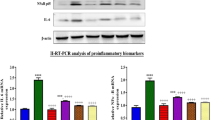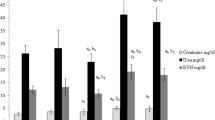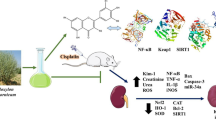Abstract
Cisplatin (CP) is a powerful anticancer agent used in the treatment of a diverse type of cancers. Oxidative stress is one of the most important side effects limiting the use of cisplatin. The protective effects of methanolic extract (ME) and ephedrine (EP), major compound, of Ephedra alata on CP-induced damages were here assessed. Treatment with CP-induced nephrotoxicity and hepatotoxicity characterized by biochemical alterations. In fact, using CP reduced significantly glutathione (GSH) levels, enzymatic activities of superoxide dismutase (SOD), catalase (CAT), glutathione-S-transferase (GST), and increased malondialdehyde (MDA) content. Nonetheless, CP-treatment induced DNA damage at renal, hepatic, and blood cells and increased interferon gamma (IFNγ) level in serum. Co-treatments of mice with ME normalized relative kidney/body weight, restored biochemical and oxidative stress parameters, reduced DNA damage and IFNγ level. In conclusion, ME exhibited the best protective effect against CP damage compared with ephedrine. This is could be attributed to the presence of polysaccharides, organic acids, flavonoids, and tannins in addition to ephedrine alkaloids. These compounds were reported to play a major role in inhibiting and scavenging free radicals, providing an effective protection against CP- induced oxidative damage.

Graphical abstract









Similar content being viewed by others
Abbreviations
- SOD:
-
Superoxide dismutase
- CAT:
-
Catalase
- GST:
-
Glutathione-S-transferase
- MDA:
-
Malondialdehyde
- IFNγ:
-
Interferon gamma
- ROS:
-
Reactive oxygen species
- DPPH:
-
1.1-diphenyl-2-picryl-hydrazyl
- AST:
-
Aspartate transaminase
- ALT:
-
Alanine transaminase
- CR:
-
Creatinine
- EDTA:
-
Ethylenediaminetetraacetic acid
- CDNB:
-
1-chloro-2,4-dinitrobenzene
- H2O2:
-
Hydrogen peroxide
- DTNB:
-
5,5′-dithiobis-(2-nitrobenzoic acid)
- Na2HPO4:
-
Sodium phosphate dibasic
- TPC:
-
Total phenolic contents
- TFC:
-
Total flavonoids contents
- GAE:
-
Gallic acid equivalents
- RE:
-
Rutin equivalents
- LD50 :
-
Median lethal dose
- TBA:
-
Thiobarbituric acid
- TCA:
-
Trichloroacetic acid
- OD:
-
Optical density
- DMSO:
-
Dimethyl sulfoxide
References
Abdelmeguid NE, Chmaisse HN, Abou Zeinab NS (2010) Silymarin ameliorates cisplatin-induced hepatotoxicity in rats: histopathological and ultrastructural studies. Pakistan journal of biological sciences : PJBS 13:463–479
Abourashed EA, El-Alfy AT, Khan IA, Walker L (2003) Ephedra in perspective--a current review. Phytotherapy research : PTR 17:703–712
Ala AA, Olotu BB, Ohia CMD (2018) Assessment of cytotoxicity of leaf extracts of Andrographis paniculata and Aspilia africana on murine cells in vitro. Archives of basic and applied medicine 6:61–65
Al-Rimawi F, Abu-Lafi S, Abbadi J, Alamarneh AAA, Sawahreh RA, Odeh I (2017) Analysis of phenolic and flavonoids of wild Ephedra alata plant extracts by Lc/Pda and Lc/Ms and their antioxidant activity. African journal of traditional, complementary, and alternative medicines : AJTCAM 14:130–141
Amakura Y, Yoshimura M, Yamakami S, Yoshida T, Wakana D, Hyuga M, Hyuga S, Hanawa T, Goda Y (2013) Characterization of phenolic constituents from ephedra herb extract. Molecules 18:5326–5334
Atessahin A, Yilmaz S, Karahan I, Ceribasi AO, Karaoglu A (2005) Effects of lycopene against cisplatin-induced nephrotoxicity and oxidative stress in rats. Toxicology 212:116–123
Attia SM (2010) The impact of quercetin on cisplatin-induced clastogenesis and apoptosis in murine marrow cells. Mutagenesis 25:281–288
Aust SD, Morehouse LA, Thomas CE (1985) Role of metals in oxygen radical reactions. Journal of free radicals in biology & medicine 1:3–25
Banerjee S, Sinha K, Chowdhury S, Sil PC (2018) Unfolding the mechanism of cisplatin induced pathophysiology in spleen and its amelioration by carnosine. Chem Biol Interact 279:159–170
Beauchamp C, Fridovich I (1971) Superoxide dismutase: improved assays and an assay applicable to acrylamide gels. Anal Biochem 44:276–287
Bradford MM (1976) A rapid and sensitive method for the quantitation of microgram quantities of protein utilizing the principle of protein-dye binding. Anal Biochem 72:248–254
Brahmi D, Ayed Y, Hfaiedh M, Bouaziz C, Mansour HB, Zourgui L, Bacha H (2012) Protective effect of cactus cladode extract against cisplatin induced oxidative stress, genotoxicity and apoptosis in balb/c mice: combination with phytochemical composition. BMC Complement Altern Med 12:111
Choi J, Kim SH, Rah YC, Chae SW, Lee JD, Md BD, Park MK (2014) Effects of caffeic acid on cisplatin-induced hair cell damage in HEI-OC1 auditory cells. Int J Pediatr Otorhinolaryngol 78:2198–2204
Collins AR, Dobson VL, Dusinska M, Kennedy G, Stetina R (1997) The comet assay: what can it really tell us? Mutat Res 375:183–193
Coskun N, Hatipoglu MT, Ozogul C, Korkmaz C, Akyol SN, Micili SC, Arik GS, Erdogan D (2013) The protective effects of acetyl L-carnitine on testis gonadotoxicity induced by cisplatin in rats. Balkan medical journal 30:235–241
Dunnick JK, Kissling G, Gerken DK, Vallant MA, Nyska A (2007) Cardiotoxicity of Ma Huang/caffeine or ephedrine/caffeine in a rodent model system. Toxicol Pathol 35:657–664
Farooqui Z, Afsar M, Rizwan S, Khan AA, Khan F (2016) Oral administration of Nigella sativa oil ameliorates the effect of cisplatin on membrane enzymes, carbohydrate metabolism and oxidative damage in rat liver. Toxicol Rep 3:328–335
Florea AM, Busselberg D (2011) Cisplatin as an anti-tumor drug: cellular mechanisms of activity, drug resistance and induced side effects. Cancers 3:1351–1371
Gong C, Qian L, Yang H, Ji LL, Wei H, Zhou WB, Qi C, Wang CH (2015) Hepatotoxicity and pharmacokinetics of cisplatin in combination therapy with a traditional Chinese medicine compound of Zengmian Yiliu granules in ICR mice and SKOV-3-bearing nude mice. BMC Complement Altern Med 15:283
He X, Li C, Wei Z, Wang J, Kou J, Liu W, Shi M, Yang Z, Fu Y (2016) Protective role of apigenin in cisplatin-induced renal injury. Eur J Pharmacol 789:215–221
Houmani H, Rodriguez-Ruiz M, Palma JM, Abdelly C, Corpas FJ (2016) Modulation of superoxide dismutase (SOD) isozymes by organ development and high long-term salinity in the halophyte Cakile maritima. Protoplasma 253:885–894
Hyuga S, Hyuga M, Oshima N, Maruyama T, Kamakura H, Yamashita T, Yoshimura M, Amakura Y, Hakamatsuka T, Odaguchi H (2016) Ephedrine alkaloids-free Ephedra herb extract: a safer alternative to ephedra with comparable analgesic, anticancer, and anti-influenza activities. J Nat Med 70:571–583
Iseri S, Ercan F, Gedik N, Yuksel M, Alican I (2007) Simvastatin attenuates cisplatin-induced kidney and liver damage in rats. Toxicology 230:256–264
Komolafe K, Olaleye TM, Omotuyi OI, Boligon AA, Athayde ML, Akindahunsi AA, Teixeira da Rocha JB (2014) In vitro antioxidant activity and effect of Parkia biglobosa bark extract on mitochondrial redox status. Journal of acupuncture and meridian studies 7:202–210
Leemans JC, Stokman G, Claessen N, Rouschop KM, Teske GJ, Kirschning CJ, Akira S, van der Poll T, Weening JJ, Florquin S (2005) Renal-associated TLR2 mediates ischemia/reperfusion injury in the kidney. J Clin Invest 115:2894–2903
Mansour HH, Hafez HF, Fahmy NM (2006) Silymarin modulates cisplatin-induced oxidative stress and hepatotoxicity in rats. J Biochem Mol Biol 39:656–661
Moatamedi Pour L, Farahnak A, Molaei Rad M, Golmohamadi T, Eshraghian M (2014) Activity assay of glutathione S-transferase (GSTs) enzyme as a diagnostic biomarker for liver hydatid cyst in vitro. Iran J Public Health 43:994–999
Moron MS, Depierre JW, Mannervik B (1979) Levels of glutathione, glutathione reductase and glutathione S-transferase activities in rat lung and liver. Biochim Biophys Acta 582:67–78
Niu C, Ma M, Han X, Wang Z, Li H (2017) Hyperin protects against cisplatin-induced liver injury in mice. Acta cirurgica brasileira 32:633–640
Nojiri T, Hosoda H, Kimura T, Tokudome T, Miura K, Takabatake H, Miyazato M, Okumura M, Kangawa K (2016) Protective effects of ghrelin on cisplatin-induced nephrotoxicity in mice. Peptides 82:85–91
Omar HA, Mohamed WR, Arab HH, Arafa E-SA (2016) Tangeretin alleviates cisplatin-induced acute hepatic injury in rats: targeting MAPKs and apoptosis. PLoS One 11:e0151649
Ortaldo JR, Mason A, Rehberg E, Moschera J, Kelder B, Pestka S, Herberman RB (1983) Effects of recombinant and hybrid recombinant human leukocyte interferons on cytotoxic activity of natural killer cells. J Biol Chem 258:15011–15015
Piccinelli AL, De Simone F, Passi S, Rastrelli L (2004) Phenolic constituents and antioxidant activity of Wendita calysina leaves (burrito), a folk Paraguayan tea. J Agric Food Chem 52:5863–5868
Reddy KP, Madhu P, Reddy PS (2016) Protective effects of resveratrol against cisplatin-induced testicular and epididymal toxicity in rats. Food and chemical toxicology : an international journal published for the British Industrial Biological Research Association 91:65–72
Sahu BD, Kuncha M, Sindhura GJ, Sistla R (2013) Hesperidin attenuates cisplatin-induced acute renal injury by decreasing oxidative stress, inflammation and DNA damage. Phytomedicine : international journal of phytotherapy and phytopharmacology 20:453–460
Santiago MJ, Fernández SN, Lázaro A, González R, Urbano J, López J, Solana MJ, Toledo B, del Castillo J, Tejedor A (2016) Cisplatin-induced non-oliguric acute kidney injury in a pediatric experimental animal model in piglets. PLoS One 11:e0149013
Sarker U, Oba S (2018) Response of nutrients, minerals, antioxidant leaf pigments, vitamins, polyphenol, flavonoid and antioxidant activity in selected vegetable amaranth under four soil water content. Food Chem 252:72–83
Singh NP, McCoy MT, Tice RR, Schneider EL (1988) A simple technique for quantitation of low levels of DNA damage in individual cells. Exp Cell Res 175:184–191
Son K (1997) Cisplatin-based interferon gamma gene therapy of murine ovarian carcinoma. Cancer Gene Ther 4:391–396
Tikoo K, Bhatt DK, Gaikwad AB, Sharma V, Kabra DG (2007) Differential effects of tannic acid on cisplatin induced nephrotoxicity in rats. FEBS Lett 581:2027–2035
Villano D, Fernandez-Pachon MS, Moya ML, Troncoso AM, Garcia-Parrilla MC (2007) Radical scavenging ability of polyphenolic compounds towards DPPH free radical. Talanta 71:230–235
Yousef MI, Saad AA, El-Shennawy LK (2009) Protective effect of grape seed proanthocyanidin extract against oxidative stress induced by cisplatin in rats. Food and chemical toxicology : an international journal published for the British Industrial Biological Research Association 47:1176–1183
Acknowledgments
The authors acknowledge the “Ministère Tunisien de l’Enseignement Supérieur et de la Recherche Scientifique” for its support.
Author information
Authors and Affiliations
Corresponding author
Ethics declarations
All experiments were performed in accordance with the guidelines for the care and use of laboratory animals as published by the US National Institute of Health. All experiments received the explicit approval of the Ethics Animal Committee in Tunisia.
Conflict of interest
The authors declare that they have no conflict of interest.
Additional information
Responsible editor: Philippe Garrigues
Publisher’s note
Springer Nature remains neutral with regard to jurisdictional claims in published maps and institutional affiliations.
Rights and permissions
About this article
Cite this article
Sioud, F., Ben Toumia, I., Lahmer, A. et al. Methanolic extract of Ephedra alata ameliorates cisplatin-induced nephrotoxicity and hepatotoxicity through reducing oxidative stress and genotoxicity. Environ Sci Pollut Res 27, 12792–12801 (2020). https://doi.org/10.1007/s11356-020-07904-3
Received:
Accepted:
Published:
Issue Date:
DOI: https://doi.org/10.1007/s11356-020-07904-3




